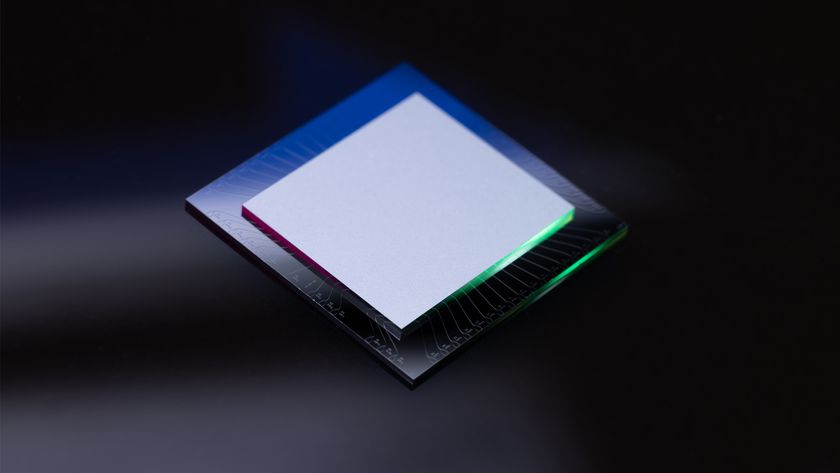Science Projects That Can Run Right on Your Home Computer

Want to help search for aliens and fight diseases right from your home computer?
A cornucopia of "volunteer computing" projects let you do that and more by donating some of the spare computational power on your desktop or laptop.
With these projects, rather than a giant, booked-up supercomputer crunching on a massive data set, thousands of regular ol' computers tackle a scientific problem that is broken up into piecemeal "jobs."
"Volunteer computing doesn’t get a single job done any faster [than a supercomputer], but it gets a whole lot of jobs done faster in a given time," said David Anderson, a research scientist at the University of California, Berkeley. "These projects encourage people to think more and learn more about science."
Anderson founded and leads a program called BOINC (Berkeley Open Infrastructure for Network Computing) that powers most science-related volunteer computing projects, many of which carry an "@home" suffix.
Often called "citizen science," this form of distributed computing has continued to catch on since it debuted in 1999 with the alien-seeking SETI@home project, which Anderson still directs.
Now over five and a half million computers around the world have one or more of the nearly 70 BOINC-enabled projects running on them. This network boasts a combined computing power of about three petaflops, or three quadrillion "floating point operations" – a calculation, essentially – per second, for a performance that beats the world's fastest supercomputer, currently the Cray Jaguar at the Oak Ridge National Laboratory in Tenn.
Sign up for the Live Science daily newsletter now
Get the world’s most fascinating discoveries delivered straight to your inbox.
To get your computer signed up to do some science, first download a free program from the websites for the projects of interest. These data-devouring applications work on Windows, Mac or Linux operating systems. The applications can run in the background while you use your computers or they can make good use of your machine's idle time.
BOINC automatically detects a computer's speed and memory to give it a job that will not gum up the works and detract from a user's experience, Anderson said.
Eventually, Anderson envisions tapping into all the extra processing power and memory on smartphones and tablet computers. So-called "virtual machine" programs that harmonize how computers handle jobs regardless of their make and model are also on BOINC's horizon, Anderson said.
Anderson hopes to involve both more scientists and computer owners in the effort. "There's a billion computers out there and that numbers' growing," he said. These machines, Anderson said, could provide the extra computational oomph needed to dramatically advance fields of science ranging from medicine to astrophysics.
Here is a look at eight of the most interesting, important or unusual volunteer science-related computing projects going on right now. (Stay tuned: TechNewsDaily will soon put together a list of "active" citizen science projects for personal computers that make scientific discovery an interactive, game-like experience.)
Einstein@home
This citizen project made news earlier this year when it announced in the journal Science the discovery of a previously unknown, unusual variety of radio pulsar. Pulsars are the ultradense, rapidly spinning remnants of giant stars that send out a beam of radiation through space like a lighthouse.
The finding represents the "first genuine astronomical discovery by a public volunteer distributed computing project," according to a statement by the Max Planck Institute for Gravitational Physics, which hosts the project along with the University of Wisconsin-Milwaukee.
Back in 2005, scientists originally launched Einstein@home to search for gravitational waves that Albert Einstein thought up almost one hundred years ago as part of his general theory of relativity.
Physicists think even the largest of these waves in spacetime caused by the movement of mass – such as a pair of neutron stars orbiting each other – peter out to the subtlest of ripples by the time they reach Earth. As such, a gravitational has not been directly detected – yet.
To remedy that, Einstein@home lends a hand in sifting through reams of data collected by Caltech's Laser Interferometer Gravitational Wave Observatory (LIGO).
Since March of last year, the Einstein@home project has also searched for radio pulsars in data gleaned from the biggest radio dish in the world, the 1,000-foot (305-meter) Arecibo Observatory in Puerto Rico.
Einstein@home presently makes use of around a quarter million computers in 192 countries. Like many of the project programs, users can pull up a visualization or a screensaver that reflects the status of the pulsar search.
Malariacontrol.net
Malaria, a mosquito-borne disease, infects several hundred million people a year, killing at least a million of them. Malariacontrol.net models the dynamics of the pathogen's spread in sub-Saharan Africa, the hot bed of the pandemic. The program even accounts for the range of human responses to the illness, such as going to a clinic at the first sign of a fever or not seeking treatment at all.
The simulations should help epidemiologists and clinicians figure out what prevention and intervention strategies, including mosquito nets, insecticide sprays and medicines, might best turn back the malarial tide.
Since 2005, some 45,000 people have contributed computer time, and the results have led to the publication of scientific papers. The Swiss Tropical and Public Health Institute is behind the effort, and financial support comes from the Bill & Melinda Gates Foundation.
SETI@home
Users can scan the heavens for signs of aliens with this project. The SETI (Search for Extra-Terrestrial Intelligence) collective effort dates back decades, and since 1999 everyday people have played a major role in listening for evidence of proverbial little green men.
SETI@home parses data gathered by the giant Arecibo Observatory radio telescope in Puerto Rico. The quarry: certain narrow-bandwidth radio signals not known to occur naturally that, if detected, would provide solid evidence of alien technologies out amongst the stars.
Processing 24 hours of data from Arecibo would take a typical single computer 330-some years, Anderson pointed out. But SETI@home's 120,000 active computers at any given time around the world can comb this data right as it comes in.
Folding@home
This long-running project launched about a year after SETI@home. Folding@home discovers how proteins get their shape during and after production in our cells. It is this three-dimensional, folded structure that determines the tiny molecule's function, or, in the case of diseases such as Alzheimer's and Parkinson's, malfunction.
Though a non-BOINC volunteer computing project, Folding@home operates in much the same way. More than 200,000 active computers achieve a blistering speed of about three petaflops per second. At present, some 73 scientific papers have been published using Folding@home's results.
By learning how proteins fold, researchers hope to come with new drugs and therapies to treat a range of illnesses and uncover fundamental insights into biology. Every computer that gets signed up moves the project closer to its goals, Folding@home's website says.
Other similar protein-folding campaigns include Rosetta@home and POEM@home.
Climateprediction.net
Administered out of the University of Oxford in the United Kingdom, Climateprediction.net describes itself as the "world's largest climate forecasting experiment for the 21st century." As scientific simulations go, climate modeling gobbles up computing power like no other, Anderson said, due to the scale and number of variables in play. "These are giant, insanely complex programs that model every aspect of Earth's climate system," Anderson said.
Climateprediction.net's purview extends over seven projects. These include simulations of geoengineering, such as humankind adding fine particles to the atmosphere to reflect some sunlight, as well as modeling various epochs in history such as the "warm Medieval period."
More than 80 million years have been modeled to date, and some 50,000 computers continue to plug away. Early results obtained back in 2005 showed that global average temperature increases over the next century could be much greater – and more devastating – than other smaller models had shown. The findings, published in Nature, influenced the most recent Intergovernmental Panel on Climate Change Report issued in late 2007, Anderson said.
Quake-Catcher Network
This BOINC-powered project does not do distributed computing in the number-crunching sense; instead, it acts like a distributed seismometer to detect earthquakes.
Laptop accelerometers, which detect if a laptop has been dropped, can pick up the ground shakes in an earthquake. For desktops, external, USB-compatible sensors are sold at cost for $49 on the project's website.
More than a thousand computers all over the world presently send seismic data in to the project's server. For now, the Quake-Catcher Network is strictly for science, not an early alarm system.
However, the dispersed setup allows for "really rapid transmission of information about earthquake locations and magnitudes," said Elizabeth Cochran, an assistant professor of seismology at the University of California, Riverside, and leader of the project. Down the road, the setup could help inform official earthquake monitoring centers, especially in countries with few full-fledged seismometers in service.
Having a lot of sensors deployed also increases the odds of narrowing down where a quake's epicenter is located, Anderson noted, "which among other things means you can detect a quake sooner," leading to crucial extra minutes of warning.
Virtual Prairie
The largest ecological simulation happening today is Virtual Prairie, led by the Universities of Houston and Rennes. It aims to model how competing plant species, from reeds to weeds to shrubs, carve out a living in the flat expanse of Midwestern grasslands. The simulation works through how the plants establish ecosystems and respond to animal foraging, pollution, seasonal variations and more.
But this project isn't just watching grass grow. Project leaders see a number of applications, such as the informing of biofuel harvesting practices, carbon capture to mitigate climate change and the preservation of biodiversity for future generations.
As of June 2010, some 3,400 active computers loaded with Virtual Prairie were zipping along at a speed of over six teraflops.
AQUA@home
The prospect of ultra-fast quantum computing has long enraptured computer scientists, physicists and cryptologists, among others. However, successfully building a full-fledged, useful quantum computer someday is likely to still take many years and require a few breakthroughs along the way.
But when that day arrives, Canada-based D-Wave Systems wants to be ready. With AQUA@home, the company harnesses volunteer computing time to help predict how well certain algorithms might run on quantum computers. Some 3,200 active users with about 6,000 computers at their disposal presently donate processing time to AQUA@home.
Geordie Rose, founder and chief technology officer at D-Wave Systems, said the project is exploring machine learning applications, such as image recognition – a sore spot for computers where humans still whip artificial intelligences.
• PCs Persist as Mobile Computing Devices Proliferate • Zettabytes Now Needed to Describe Global Data Overload • 10 Profound Innovations Ahead



